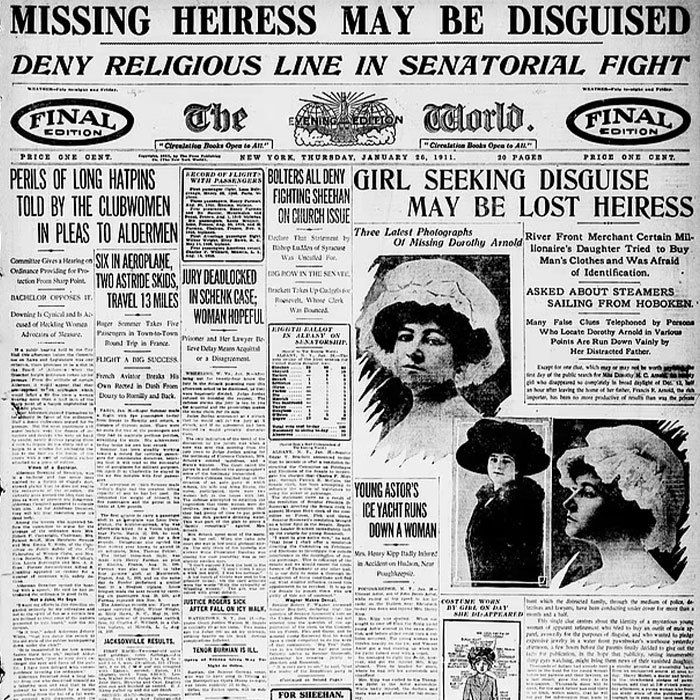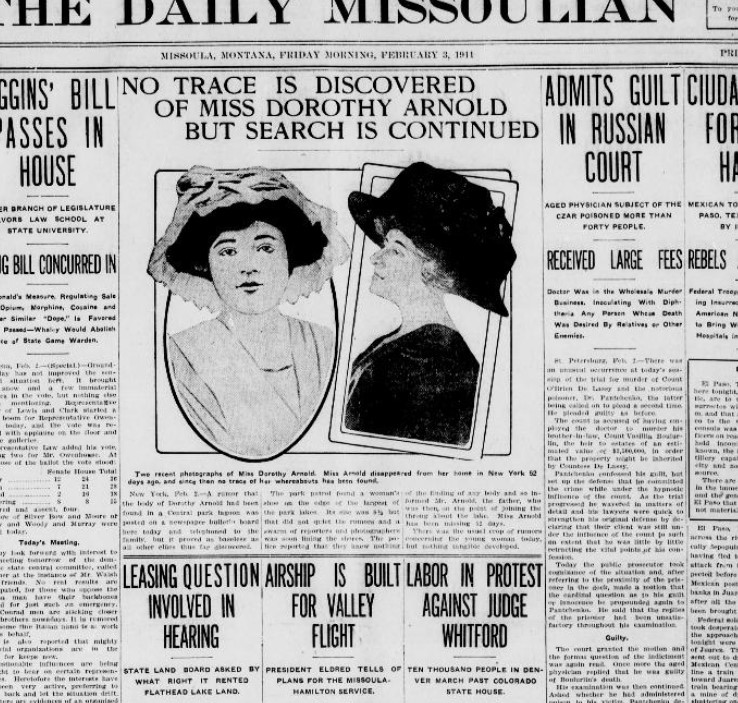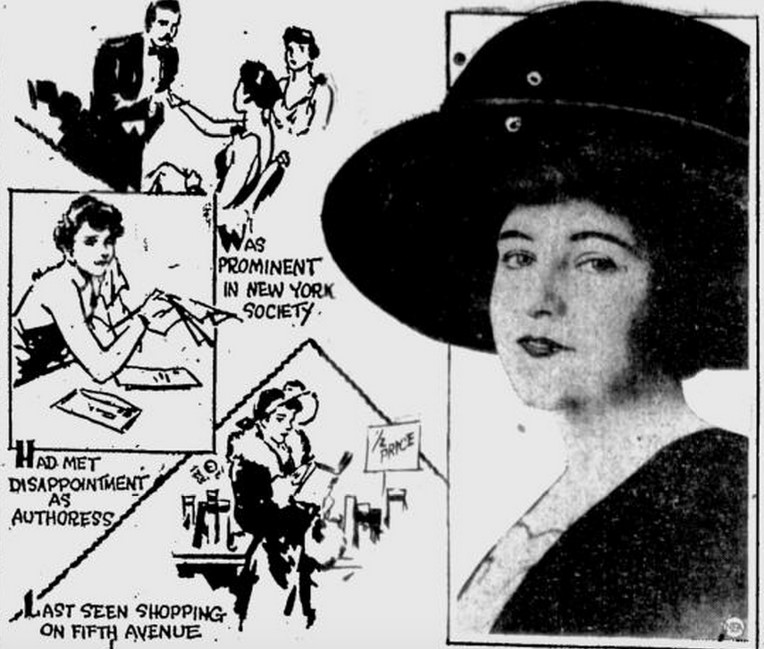New York’s Greatest Mystery: The Disappearance Of Dorothy Arnold
On December 12, 1910, Dorothy Harriet Camille Arnold, a young socialite from the Upper East Side of New York City, left her home with plans to shop for her younger sister’s debutante ball. She told her mother she would be back soon, but after walking out the door, Dorothy never came back home.
It’s the oldest missing person case in The Charley Project, which tracks over 15,000 unsolved cases. More than a century later, the mystery of what happened to Dorothy Arnold still sparks intrigue and debate.
Was she kidnapped, murdered, or did she choose to disappear and start a new life? The uncertainty surrounding her case continues to puzzle people to this day.
Dorothy Harriet’s background

Dorothy Harriet Camille Arnold, born into a wealthy family in Manhattan, appeared to have everything. Her father was a perfume importer, and her uncle served as a Supreme Court justice. Dorothy attended Bryn Mawr College in Pennsylvania, where she studied literature and language, graduating in 1905. Afterward, she returned to her family’s home.
In the fall of 1910, Dorothy, eager for independence, asked her father for permission to move into her own apartment in Greenwich Village, an area known for its vibrant artist community. However, her father did not support her request, as noted in American Heritage’s 1960 article, “The Girl Who Never Came Back.”
Dorothy had dreams of becoming a writer. From her mansion on the Upper East Side, she wrote several short stories, including Poinsettia Flames and Lotus Leaves, and sent them off for publication. McClure’s Magazine rejected the first story, and she never heard back about the second.
During this time, Dorothy regularly wrote to George S. Griscom, Jr., sharing her struggles. In one letter, she revealed her disappointment after McClure’s rejection: “Failure stares me in the face. All I see ahead is a long road with no turning.”
What happened that morning?

On the morning of her disappearance, Dorothy walked from her mansion at 108 East 79th Street, carrying $25–30 in cash—about $1,000 in today’s money. She made a stop at the Park & Tilford store to buy a half-pound box of chocolates, then continued south toward Brentano’s bookstore. There, she purchased Engaged Girl Sketches, a book of humorous essays by Emily Calvin Blake.
Outside the bookstore, located at 27th Street and Fifth Avenue, Dorothy ran into her friend Gladys King. According to Gladys, Dorothy appeared to be in good spirits during their chat. Dorothy mentioned that she planned to take a walk through Central Park on her way home.
The mysterious disappearance

The Arnolds started suspecting something had happened to Dorothy when she didn’t return home that night. After reaching out to friends, they realized no one knew where she was. The next morning, they decided to hire private investigators.
Although contacting the police would have increased the search effort, it also meant involving the media and possibly damaging their reputation. To avoid this, Dorothy’s family turned to the Pinkerton Agency for help, keeping the matter out of the public eye while still seeking assistance.
On a cold December day, Dorothy Arnold was seen dressed in a blue skirt suit, her hair styled in a full pompadour beneath a black velvet hat adorned with blue silk roses. She carried a large black fox muff with white tips, along with about $20 to $30 in cash, cards, and possibly other papers.
By January, New York’s police commissioner sent three detailed portraits of Dorothy to police in major cities across the country. These included a picture of her in a walking outfit, an evening dress, and a bust portrait.
Despite this extensive effort, the 5-foot, 4-inch woman with dark brown hair, grayish blue eyes, and a bright complexion was not found. Authorities claimed to have thoroughly searched every steamer to Europe, checking the passengers closely.
A $1,000 reward (equivalent to about $33,000 today) was offered for any information leading to her whereabouts.
Different theories

Once news broke of Dorothy’s mysterious disappearance, public interest surged, sparking theories from all sides.
An article published in the New York Times on January 26, 1911, wrote, “There is no trace of insanity in the family, and the young woman had never shown signs of a troubled mind, although she was devoted to books and spoke several languages.”
Some speculated she may have run off with a man, a theory that police looked into by investigating “every man with whom Miss Arnold was known to have been upon friendly terms.” This line of inquiry was eventually dismissed.
“Neither had she ever had a serious attachment for any man, accounting to members of her family. They all scout the idea of suicide,” the article continued.
Though Dorothy was not engaged, she did have secret meetings with George Griscom Jr., a 40-year-old unemployed man she’d known since her college days in Pennsylvania.
Dorothy Arnold’s Secret Romance

Two months before she disappeared, the socialite told her family she was visiting an old classmate in Cambridge. Instead, she secretly stayed with George at Boston’s Hotel Essex, using money from pawning her jewelry. According to family friends, the Arnolds knew about Dorothy’s relationship with George and were firmly against it. Their disapproval led Dorothy to continue seeing him without their knowledge.
After discovering letters between Dorothy and Griscom, Dorothy’s mother and brother went to Italy to confront him. According to The Times, their lawyer had “not denied” reports that Dorothy’s brother had punched Griscom, with one blow knocking him to the ground. This confrontation led to the family reclaiming a letter Griscom had kept in his pocket.
Meanwhile, George Griscom claimed he had no idea where Dorothy was but insisted he still planned to marry her if they reunited. Griscom even placed ads in New York newspapers, signing them “Junior” and pleading for her to reach out to him.
Speculation of Death Due to a Botched Abortion Procedure

In 1914, rumors started circulating that Dorothy had died from a failed abortion procedure after police raided a Pittsburgh “maternity hospital” infamously called the “House of Mystery.”
Dr. C. C. Meredith, a physician at this secretive abortion clinic, claimed Dorothy was one of several women who had died during such procedures at his hands. He also stated that her body had been cremated in the hospital’s cellar. In response, Dorothy’s father dismissed the theory as “ridiculous and absolutely untrue.”
Two years after Dorothy vanished, a convicted felon named Edward Glennoris claimed he was paid $250 to bury her body in the cellar of a New York home in December 1910. He said a man known as “Doc” told him the woman had died during an operation at a home in West Point. In response, police searched several homes in the area but came up empty-handed, finding no remains.
The Endless Search for Dorothy

Over the years, the family received countless letters from women claiming to be the missing heiress, and supposed sightings of Dorothy popped up from around the country. However, authorities verified that both the letters and these sightings were untrue.
“A hundred years later, I don’t expect any kind of resolution,” Jane Vollmer, Dorothy’s great-niece, told National Geographic. Jane first learned about Dorothy’s case from a newspaper article when she was 30 years old.
“The sensationalism was so hurtful to the family, even today,” said Martha LaFata, another Vollmer sibling. “The best thing I can do for the family is not engage in speculation and respect the fact that these people are gone.”
Jane’s mother, Rebecca, had inherited Dorothy’s letters after another family member’s passing, but she chose to destroy them all.
Mark Vollmer, another of Rebecca’s children, said, “If there was a family secret, my mother might have never known. And if she did, it went to the grave with her.”

